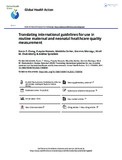| dc.contributor.author | Chang, Karen T. | |
| dc.contributor.author | Hossain, Puspita | |
| dc.contributor.author | Sarker, Malabika | |
| dc.contributor.author | Montagu, Dominic | |
| dc.contributor.author | Chakraborty, Nirali M. | |
| dc.contributor.author | Sprockett, Andrea | |
| dc.date.accessioned | 2022-04-12T07:49:30Z | |
| dc.date.available | 2022-04-12T07:49:30Z | |
| dc.date.copyright | 2020 | |
| dc.date.issued | 2020-07-13 | |
| dc.identifier.citation | Chang, K. T., Hossain, P., Sarker, M., Montagu, D., Chakraborty, N. M., & Sprockett, A. (2020). Translating international guidelines for use in routine maternal and neonatal healthcare quality measurement. Global Health Action, 13(1) doi:10.1080/16549716.2020.1783956 | en_US |
| dc.identifier.uri | http://hdl.handle.net/10361/16543 | |
| dc.description | This article was published in Global Health Action [ © 2020 The Author(s). Published by Informa UK Limited, trading as Taylor & Francis Group. This is an Open Access article distributed under the terms of the Creative Commons Attribution License (http://creativecommons.org/licenses/by/4.0/)] and the definite version is available at:
https://doi.org/10.1080/16549716.2020.1783956 The Journal's website is at: https://www.tandfonline.com/doi/full/10.1080/16549716.2020.1783956 | en_US |
| dc.description.abstract | Background: Improving facility-based quality for maternal and neonatal care is the key to
reducing morbidity and mortality rates in low- and middle-income countries. Recent guidance from WHO and others has produced a large number of indicators to choose from to
track quality.
Objective: To explore how to translate complex global maternal and neonatal health standards into actionable application at the facility level.
Methods: We applied a two-step process as an example of how the 352 indicators in WHO’s
2016 Standards for Improving Quality of Maternal and Newborn Care in Health Facilities
might be reduced to only those with the strongest evidence base, associated with outcomes,
and actionable by facility managers. We applied Hill criteria and assessed whether indicators
were within the control of facility managers. We next conducted a rapid review of supporting
literature and applied GRADE analysis, retaining those with scores of ‘moderate’ or ‘high’. To
understand the utility and barriers to measuring this limited set of indicators in practice, we
undertook a case study of hypothetical measurement application in two districts in
Bangladesh, interviewing 25 clinicians, managers, and other stakeholders.
Results: From the initial 352 indicators, 56 were retained. The 56 indicators were used as
a base for interviews. Respondents emphasized the practical challenges to the use of complex
guides and the need for parsimonious and actionable sets of quality indicators.
Conclusions: This work offers one way to move towards a reduced quality indicator set,
beginning from current WHO guidance. Despite study limitations, this work provides evidence of the need for reduced and evidence-based sets of quality indicators if guides are to
be used to improve quality in practice. We hope that future research will build on and refine
our efforts. Measuring quality effectively so that evidence guides and improves practice is the
first step to assuring safe maternal and neonatal care. | en_US |
| dc.language.iso | en_US | en_US |
| dc.publisher | Taylor & Francis | en_US |
| dc.relation.uri | https://www.tandfonline.com/doi/full/10.1080/16549716.2020.1783956 | |
| dc.subject | Quality of care | en_US |
| dc.subject | Measurement | en_US |
| dc.subject | Maternal health | en_US |
| dc.subject | Neonatal health | en_US |
| dc.subject | Management | en_US |
| dc.subject | Low- and middle-income | en_US |
| dc.subject | Bangladesh | en_US |
| dc.title | Translating international guidelines for use in routine maternal and neonatal healthcare quality measurement | en_US |
| dc.type | Journal Article | en_US |
| dc.description.version | Published | |
| dc.contributor.department | Brac James P. Grant School of Public Health | |
| dc.identifier.doi | https://doi.org/10.1080/16549716.2020.1783956 | |
| dc.relation.journal | Global Health Action | |

